The MSI GE76 Raider Review: Tiger Lake Plus Ampere Equals Framerate
by Brett Howse on September 8, 2021 9:00 AM EST- Posted in
- Laptops
- Gaming
- Intel
- MSI
- NVIDIA
- Core
- Tiger Lake
- GeForce RTX
- Ampere
- Tiger Lake-H
- TGL-H
Display Analysis
MSI offers a fairly wide-range of display options for the GE76 Raider. There is the eSports-focused 360 Hz FHD panel found in our review unit, along with a pair of QHD panels with 165 Hz and 240 Hz refresh. There is even a UHD panel with an impressive 120 Hz refresh rate. MSI’s options are all excellent and all offer the high-refresh that would be expected in a gaming system.
The 360 Hz display in the review unit is of course incredibly smooth, but also seems like a bit of a specification that is just being increased to say you have increased it and show a higher number to make people think they are getting something better. As seen in our gaming tests, even older games really came nowhere near 360 frames per second. There are going to be some diminishing returns even if the game could actually run at that framerate. This unit has no variable refresh rate technology, and so the options are either 360 Hz if you can hit it, or can deal with repeated frames, or 60 Hz - there are no inbetween options.
MSI has historically done very well with display accuracy, and they offer a TrueColor application that allows the user to choose various color modes, including a sRGB mode. This is always a nice benefit of the MSI ecosystem, and it is nice to see MSI not fall for the trap of P3 color gamut support, since it is not handled very well in Windows 10 at all.
To see how the display performs, we leverage Portrait Display’s Calman software suite with a custom workflow. Brightness and contrast measurements are done with the X-Rite i1Display Pro colorimeter, and color accuracy testing is done with the X-Rite i1Pro2 spectrophotometer.
Brightness and Contrast
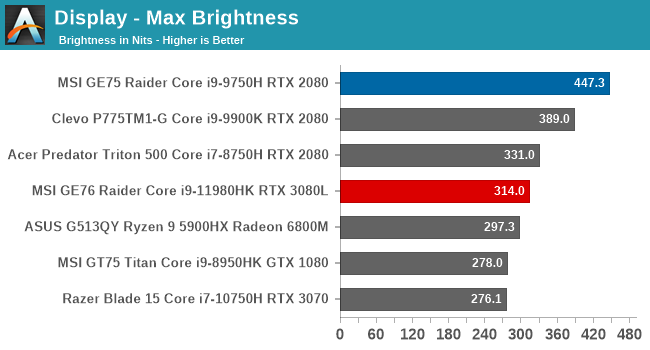

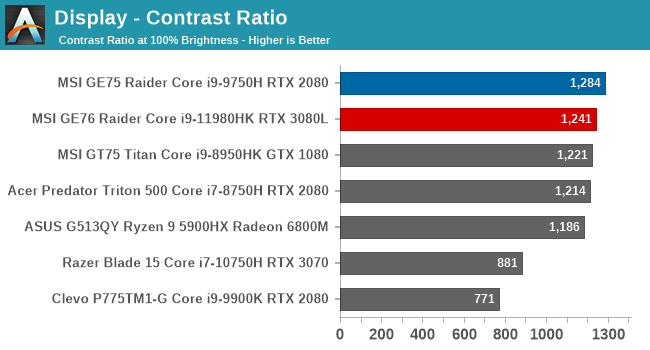
With just 314 nits of brightness, the GE76 Raider is very average for a gaming system. It does offer reasonable black levels and good contrast, but for those not playing in a dark environment, more brightness would be appreciated.
Grayscale
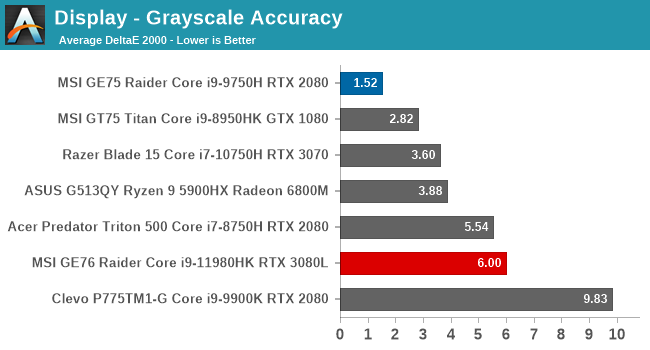
Immediately, the MSI GE76 Raider throws up a curveball here. MSI notebooks tend to have fairly good color accuracy out of the box, and with the ability to choose sRGB with the included software, often are near the top of our gaming notebook accuracy charts, but the 360 Hz display found in the GE76 Raider is anything but accurate, sacrificing some of that accuracy for the higher refresh rate as is sometimes the case with these sorts of panels.
Gamut
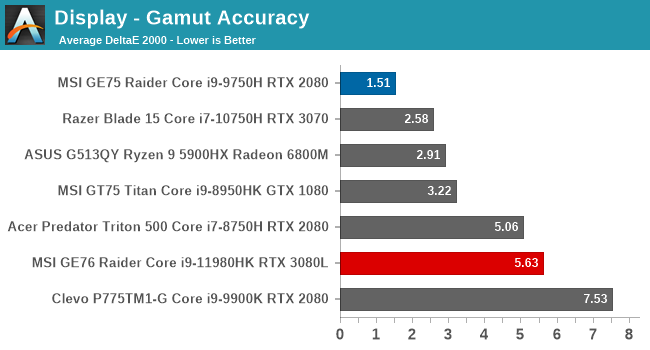
The gamut test checks the color levels for 100% brightness of the primary and secondary colors, and again, the GE76 Raider does not do very well here compared to the older GE75 Raider. It is not able to cover the entire sRGB gamut with its backlighting.
Saturation
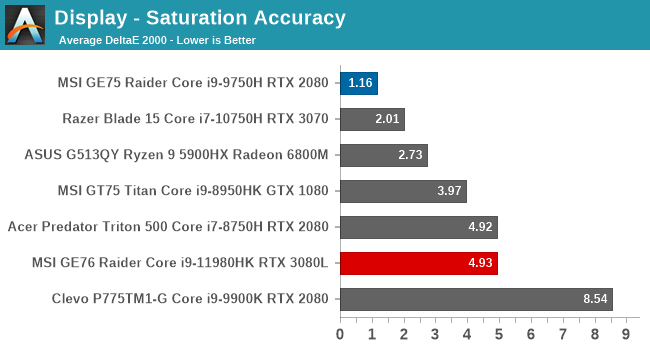
In comparison to the gamut test which just checks the primary and secondary colors at 100% levels, the saturation sweep checks at 4-bit steps from 0% to 100%. Considering the previous results it is likely no surprise that the GE76 Raider performed poorly here.
Gretag Macbeth
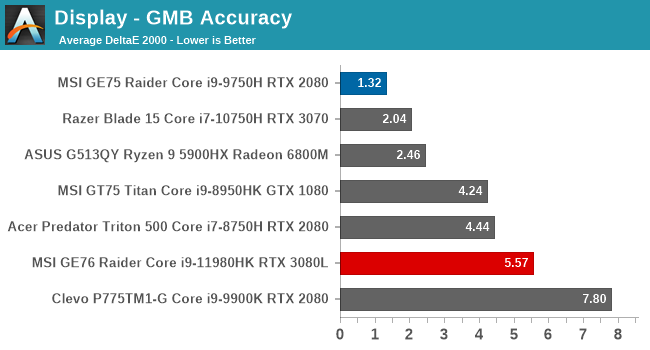
The final test moves off of the primary and secondary color axis, and includes a lot more colors from all over the spectrum, including the important skin tones. There are some very high error levels detected here, dragging the average down quite a bit.
Colorchecker
To give a relative example of the color accuracy of the display, the colorchecker swatch shows the targeted color on the bottom, and the color achieved by the display on the top. The display in this notebook is significantly missing its targets pretty much across the spectrum.
Display Conclusion
If the price of a 360 Hz display is poor color accuracy, it is really the wrong direction. The previous generation GE75 was one of the most accurate gaming notebook displays we had tested, and it still included a 144 Hz display. Moving to such a high refresh rate is apparently detrimental to the overall experience, as the system can not achieve those kinds of framerates in really any game on the market. There is also the other elephant in the room, which is the lack of G-SYNC support on the Raider notebooks, which again, makes the high-refresh rate display less of an asset.
Considering MSI’s strong performance in the past, the results of the GE76 Raider are really very underwhelming.


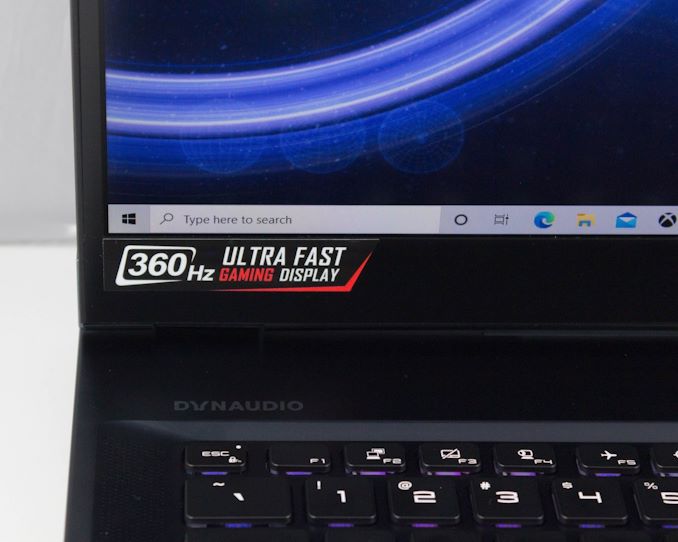













33 Comments
View All Comments
Alistair - Wednesday, September 8, 2021 - link
Even the Raider with the 3070 is $1999 right now, it is more interesting than reviewing the top of the line model.grant3 - Wednesday, September 8, 2021 - link
Comparing a mysterious, open-box 3070 laptop, with this up-spec'd, new-in-box, 3080 laptop... what's the point?If someone thinks 3070 is as good as 3080 can buy this laptop starting at $2250 (according to the article) so immediately the price difference is halved.
lemurbutton - Wednesday, September 8, 2021 - link
Just wait for the M2X Macbook Pros later this year. Yes, I said M2X because it will come after the iPhone 13 and will utilize the A15 core.abufrejoval - Wednesday, September 8, 2021 - link
Go eat some gallium arsenide thee nasty bot!wrkingclass_hero - Wednesday, September 8, 2021 - link
Tomb Raider pulling out 10w more than the power supply can deliver is not good, it means you'll be losing charge as you play and the increased wear on the battery will cause the capacity to decay much faster.Yojimbo - Wednesday, September 8, 2021 - link
They measured power draw at the wall, not after the power supply. Since the GE76 power supply is rated for 280 W that means it can supply 280 W to the system. There is loss in the power conversion process. If it's drawing 290 W from the wall I'm guessing it should be well within the limits of the power supply, as even if it had 90% efficiency at 290 W it would be providing 261 W to the system, which is well under the 280 W limit.Yojimbo - Wednesday, September 8, 2021 - link
Oh, also, by measuring at the wall we can know for certain that the power supply is providing the power resulting from the 290 W draw: any power coming from the battery would not be measurable at the wall.The_Assimilator - Wednesday, September 8, 2021 - link
360Hz displays exist only to single out stupid people.Awful - Wednesday, September 8, 2021 - link
Yes... those that complain about a niche requirement they haven't understood. It's for eSports. (check out blurbusters.com or similar if you actually want to understand it).Lonyo - Thursday, September 9, 2021 - link
Surely if you are testing a desktop replacement, a meaningful comparison point in benchmarks would be... a desktop?That way you can see what level of tradeoff you are making in performance for the advantages of the form factor. Otherwise... you're comparing a laptop to other laptops, even though you say it's a desktop replacement.